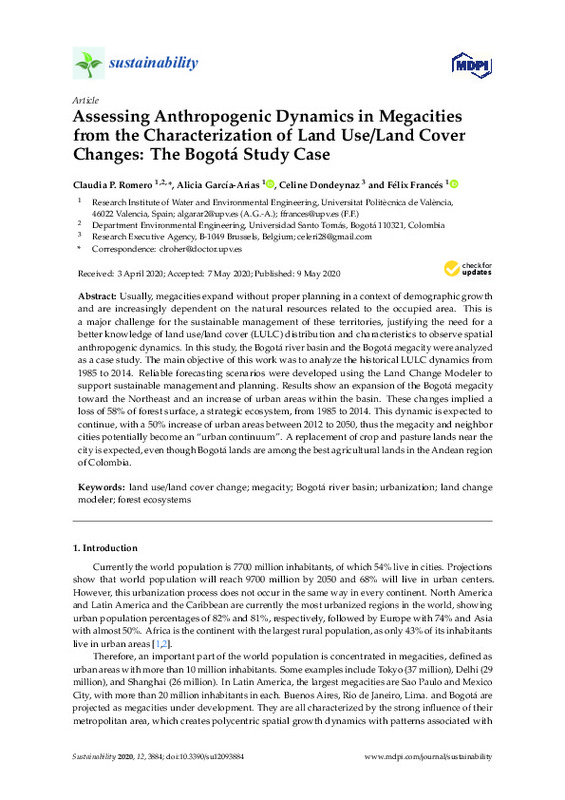Aguilar, A. G., Ward, P. M., & Smith Sr, C. . (2003). Globalization, regional development, and mega-city expansion in Latin America: Analyzing Mexico City’s peri-urban hinterland. Cities, 20(1), 3-21. doi:10.1016/s0264-2751(02)00092-6
Kourtit, K., Nijkamp, P., & Reid, N. (2014). The new urban world: Challenges and policy. Applied Geography, 49, 1-3. doi:10.1016/j.apgeog.2014.01.007
Lin, Y.-P., Chu, H.-J., Wu, C.-F., & Verburg, P. H. (2011). Predictive ability of logistic regression, auto-logistic regression and neural network models in empirical land-use change modeling – a case study. International Journal of Geographical Information Science, 25(1), 65-87. doi:10.1080/13658811003752332
[+]
Aguilar, A. G., Ward, P. M., & Smith Sr, C. . (2003). Globalization, regional development, and mega-city expansion in Latin America: Analyzing Mexico City’s peri-urban hinterland. Cities, 20(1), 3-21. doi:10.1016/s0264-2751(02)00092-6
Kourtit, K., Nijkamp, P., & Reid, N. (2014). The new urban world: Challenges and policy. Applied Geography, 49, 1-3. doi:10.1016/j.apgeog.2014.01.007
Lin, Y.-P., Chu, H.-J., Wu, C.-F., & Verburg, P. H. (2011). Predictive ability of logistic regression, auto-logistic regression and neural network models in empirical land-use change modeling – a case study. International Journal of Geographical Information Science, 25(1), 65-87. doi:10.1080/13658811003752332
Rothwell, A., Ridoutt, B., Page, G., & Bellotti, W. (2015). Feeding and housing the urban population: Environmental impacts at the peri-urban interface under different land-use scenarios. Land Use Policy, 48, 377-388. doi:10.1016/j.landusepol.2015.06.017
Haas, J., & Ban, Y. (2014). Urban growth and environmental impacts in Jing-Jin-Ji, the Yangtze, River Delta and the Pearl River Delta. International Journal of Applied Earth Observation and Geoinformation, 30, 42-55. doi:10.1016/j.jag.2013.12.012
Tian, L., Li, Y., Yan, Y., & Wang, B. (2017). Measuring urban sprawl and exploring the role planning plays: A shanghai case study. Land Use Policy, 67, 426-435. doi:10.1016/j.landusepol.2017.06.002
Veldkamp, A., & Fresco, L. O. (1996). CLUE: a conceptual model to study the Conversion of Land Use and its Effects. Ecological Modelling, 85(2-3), 253-270. doi:10.1016/0304-3800(94)00151-0
Kok, K. (2004). The role of population in understanding Honduran land use patterns. Journal of Environmental Management, 72(1-2), 73-89. doi:10.1016/j.jenvman.2004.03.013
Brown, L. A. (2014). The city in 2050: A kaleidoscopic perspective. Applied Geography, 49, 4-11. doi:10.1016/j.apgeog.2013.09.003
Islam, M. S., & Ahmed, R. (1970). Land Use Change Prediction In Dhaka City Using Gis Aided Markov Chain Modeling. Journal of Life and Earth Science, 6, 81-89. doi:10.3329/jles.v6i0.9726
Sangermano, F., Toledano, J., & Eastman, J. R. (2012). Land cover change in the Bolivian Amazon and its implications for REDD+ and endemic biodiversity. Landscape Ecology, 27(4), 571-584. doi:10.1007/s10980-012-9710-y
He, Y., Ai, B., Yao, Y., & Zhong, F. (2015). Deriving urban dynamic evolution rules from self-adaptive cellular automata with multi-temporal remote sensing images. International Journal of Applied Earth Observation and Geoinformation, 38, 164-174. doi:10.1016/j.jag.2014.12.014
Vásquez, D. L. A., Balslev, H., & Sklenář, P. (2015). Human impact on tropical-alpine plant diversity in the northern Andes. Biodiversity and Conservation, 24(11), 2673-2683. doi:10.1007/s10531-015-0954-0
Alonso, D. L., Pérez, R., Okio, C. K. Y. A., & Castillo, E. (2020). Assessment of mining activity on arsenic contamination in surface water and sediments in southwestern area of Santurbán paramo, Colombia. Journal of Environmental Management, 264, 110478. doi:10.1016/j.jenvman.2020.110478
Hofstede, R. G. M. (1995). The effects of grazing and burning on soil and plant nutrient concentrations in Colombian p�ramo grasslands. Plant and Soil, 173(1), 111-132. doi:10.1007/bf00155524
Buytaert, W., Célleri, R., De Bièvre, B., Cisneros, F., Wyseure, G., Deckers, J., & Hofstede, R. (2006). Human impact on the hydrology of the Andean páramos. Earth-Science Reviews, 79(1-2), 53-72. doi:10.1016/j.earscirev.2006.06.002
Bocarejo, J. P., Portilla, I., & Pérez, M. A. (2013). Impact of Transmilenio on density, land use, and land value in Bogotá. Research in Transportation Economics, 40(1), 78-86. doi:10.1016/j.retrec.2012.06.030
Mas, J.-F., Kolb, M., Paegelow, M., Camacho Olmedo, M. T., & Houet, T. (2014). Inductive pattern-based land use/cover change models: A comparison of four software packages. Environmental Modelling & Software, 51, 94-111. doi:10.1016/j.envsoft.2013.09.010
Pontius, R. (2018). Criteria to Confirm Models that Simulate Deforestation and Carbon Disturbance. Land, 7(3), 105. doi:10.3390/land7030105
Jat, M. K., Choudhary, M., & Saxena, A. (2017). Application of geo-spatial techniques and cellular automata for modelling urban growth of a heterogeneous urban fringe. The Egyptian Journal of Remote Sensing and Space Science, 20(2), 223-241. doi:10.1016/j.ejrs.2017.02.002
Stellian, R., & Danna-Buitrago, J. P. (2017). Competitividad de los productos agropecuarios colombianos en el marco del tratado de libre comercio con los Estados Unidos: análisis de las ventajas comparativas. Revista de la CEPAL, 2017(122), 139-163. doi:10.18356/7fc7c097-es
SAUNDERS, D. A., HOBBS, R. J., & MARGULES, C. R. (1991). Biological Consequences of Ecosystem Fragmentation: A Review. Conservation Biology, 5(1), 18-32. doi:10.1111/j.1523-1739.1991.tb00384.x
Fischer, J., & Lindenmayer, D. B. (2007). Landscape modification and habitat fragmentation: a synthesis. Global Ecology and Biogeography, 16(3), 265-280. doi:10.1111/j.1466-8238.2007.00287.x
ROJAS, I., BECERRA, P., GÁLVEZ, N., LAKER, J., BONACIC, C., & HESTER, A. (2011). Relationship between fragmentation, degradation and native and exotic species richness in an Andean temperate forest of Chile. Gayana. Botánica, 68(2), 163-175. doi:10.4067/s0717-66432011000200006
Mendoza S., J. E., & Etter R., A. (2002). Multitemporal analysis (1940–1996) of land cover changes in the southwestern Bogotá highplain (Colombia). Landscape and Urban Planning, 59(3), 147-158. doi:10.1016/s0169-2046(02)00012-9
Oviedo Hernandez, D., & Dávila, J. D. (2016). Transport, urban development and the peripheral poor in Colombia — Placing splintering urbanism in the context of transport networks. Journal of Transport Geography, 51, 180-192. doi:10.1016/j.jtrangeo.2016.01.003
[-]









